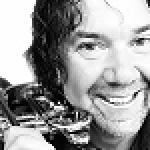WindWorks Trumpet Academy › Forums › WindWorks › Backswing point of difference
- This topic has 5 replies, 3 voices, and was last updated 5 years, 4 months ago by
 Greg Spence.
Greg Spence.
-
AuthorPosts
-
-
26 November 2018 at 9:56 am #12416
eric
ParticipantI am very excited that today I discovered that I have tension beginning as soon as the backswing. How about that for starting at the beginning! Anyway, at end-inspiration as the air transitions to the slingshot, i.e. that millisecond moment where the inspiratory volume reaches capacity and flow reverses, I discovered a catch, hiccup, choke, or whatever you wish to call it, just before the slingshot release. I am certain that this tension carries and increases as I release even if I think it is a “passive release.” I think this is an important discovery. Now, I am uncertain what to do next.
I experimented with a smaller inspiratory capacity in hopes that less inspired volume would lead to less tension, but it unfortunately did not help. I also tried experimenting with an end-inspiratory breath hold trying to keep to throat open and avoid Valsalva. Although I can maintain this hold without feeling tension, as soon as I release, the hiccup in flow begins.
Does anyone have any specific recommendations and exercises?
-
26 November 2018 at 11:06 am #12421
eric
ParticipantTo clarify, this happens with and without the horn.
-
26 November 2018 at 11:55 am #12426
 Greg SpenceKeymaster
Greg SpenceKeymasterHey Eric, this hopefully serves as a great lesson to anyone reading. THAT is how deep you have to look. With your magnifying glass out, you discovered an important flaw that must be fixed; it went unnoticed for years right?!
So you are on the right path but need to break it down even further. With bent finger in mouth BCH BREATH, take a really slow inhalation, maybe 1/10th of a full breath – try just releasing and engaging the abdominal muscles, opening up that vacuum so you don’t actually feel like you are “taking a breath”.
Do it REALLY slowly! THIS MUST BE DONE WITH EYES CLOSED AND ATTENTION TO THE THROAT. Do it several times… did I mention slowly? Don’t hold the breath, simply turn it around. There should be no catch whatsoever… am I right?
Increase it to 2/10ths (20%) of a full breath, now you will feel slightly more activity from the body but certainly no strain or tension, just subtle movement. Slowly, eyes closed.
Continue taking deeper breaths until you find the trigger point. You have probably been taking TOO much air in.
Let me know how you go.
Cheers,
Greg -
26 November 2018 at 9:02 pm #12458
 SimesParticipant
SimesParticipantI have also recognised this tension recently after looking into it more closely and Gregs demonstration in his recent workshop of a student he had that took a big breath, but then held the breath in their throat with an open mouth.
I don’t quite suffer to that extent but have come too realise how much of a ‘throat player’ I had become over my many years of playing. I am making some good progress on Gregs new course now (thanks a million, Greg!) but on this issue, one of the recent things I have experimented with in practice or any time during the day, is after BCH breath, to fill my cheeks with air (a la Dizzy Gillespie – the lips are the last point of resistance), releasing with a ‘PUH’ just a few times, encourages me to relax the throat more and a good ‘release’ feeling.
Obviously, I don’t play like this but the psychology is helping me understand more.
I don’t know if that’s consistent with Gregs methods so please shoot me down if not. 🙂Cheers
Simon
-
3 December 2018 at 10:57 pm #12813
eric
ParticipantThanks everyone. After one week, it is clear that I was taking two large of a breath with the backswing which led to tension from the start. There has been some improvement this week for which I am grateful.
Wile having the magnifying glass out, I have noticed another issue right from the start. Greg, when you discuss placement of the visualizer over the lips, you discuss threading the airstream. When using the tissue, I notice that when I place the visualizer on the lips, the tissue does not move as freely as you demonstrate in the videos despite being in a comfortable place. I can create a more free movement by moving the visualizer more onto the upper lip (>60-70% upper lip), pressing more firmly on the upper lip than the lower while keeping ~50-50% upper/lower, or tilting the lower portion of the visualizer forward off the lips. This seems to me that my airstream is moving upward.
The question has to do with placement of the visualizer which then leads to placement of the mouthpiece etc. Recognizing that the shape of everyone’s mouth and lips is different, am I correct in stating that I should move the visualizer/mouthpiece to the location of greatest airflow regardless of location? Is this an issue where I need to keep the visualizer/mouthpiece centered but somehow manipulate the direction of airflow?
I am a comeback player who has only played for a couple of years after a 25 year hiatus, and this course has been tremendous.
-
4 December 2018 at 8:55 am #12829
 Greg SpenceKeymaster
Greg SpenceKeymaster@Simes, there is no “one way” to release throat tension and if it is working for you then go right ahead!!! 🙂
@Eric, It is all about discovering the “sensation of freedom” so I urge you to try doing exactly as I do in the video. If your airstream is hitting the tissue, straight out, with a natural jaw position, login says you could lightly place the visualiser and get exactly the same impact on the tissue. It might feel insane, don’t worry about that. Give it a try. cheers, Greg
-
-
AuthorPosts
- You must be logged in to reply to this topic.
Recent topics
-
1.O / 2.0 routine
by
jice.gif
2 months ago -
Abdominal surgery and time off the trumpet
by
DQ
6 months, 3 weeks ago -
Allegro or Presto Practice Routine
by
djm297
7 months, 2 weeks ago -
Tongue lock – Throat lock
by
Ivo Carrabs
8 months ago -
Mouthpiece placement and shape
by
Ivo Carrabs
7 months, 3 weeks ago
